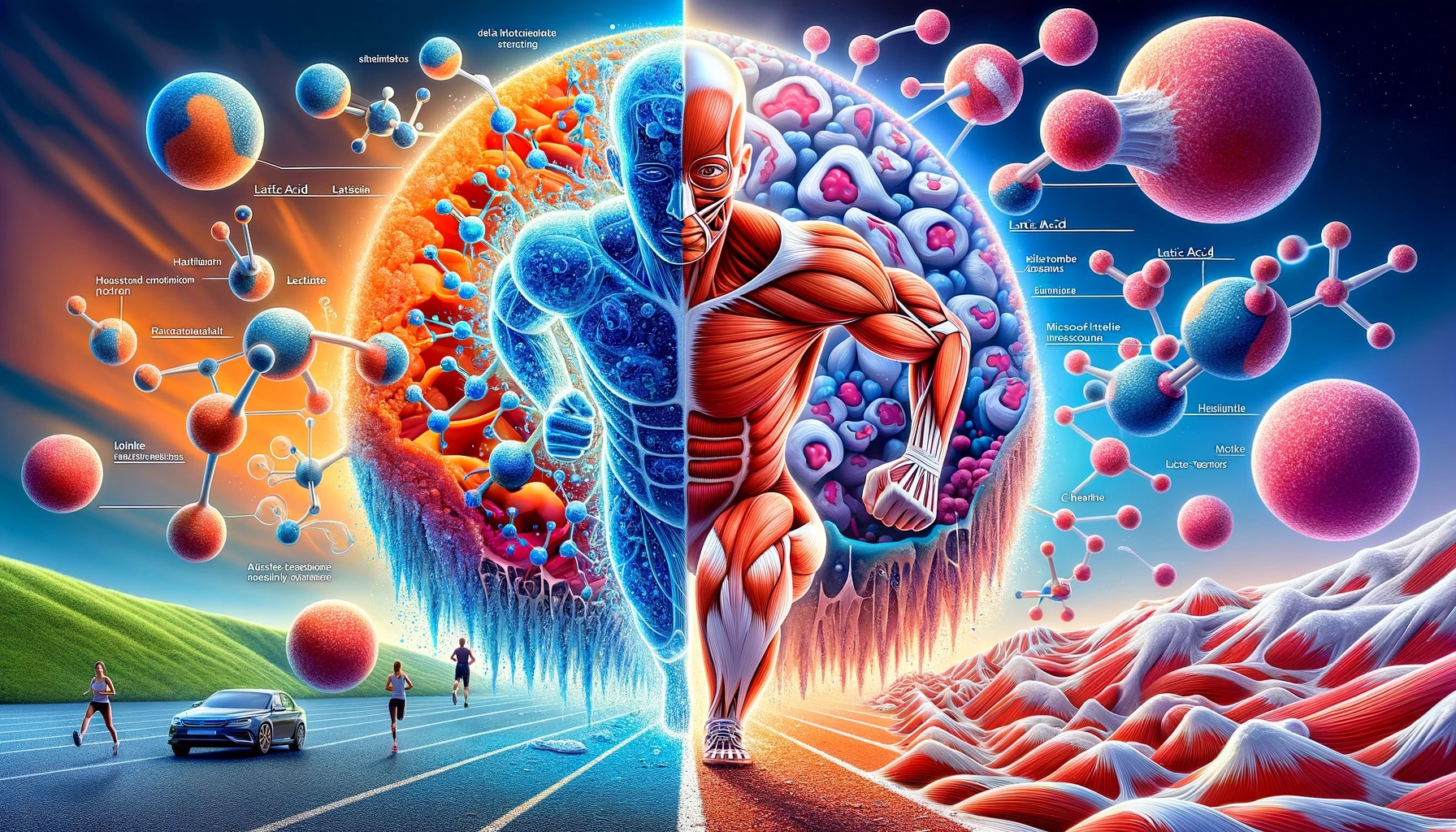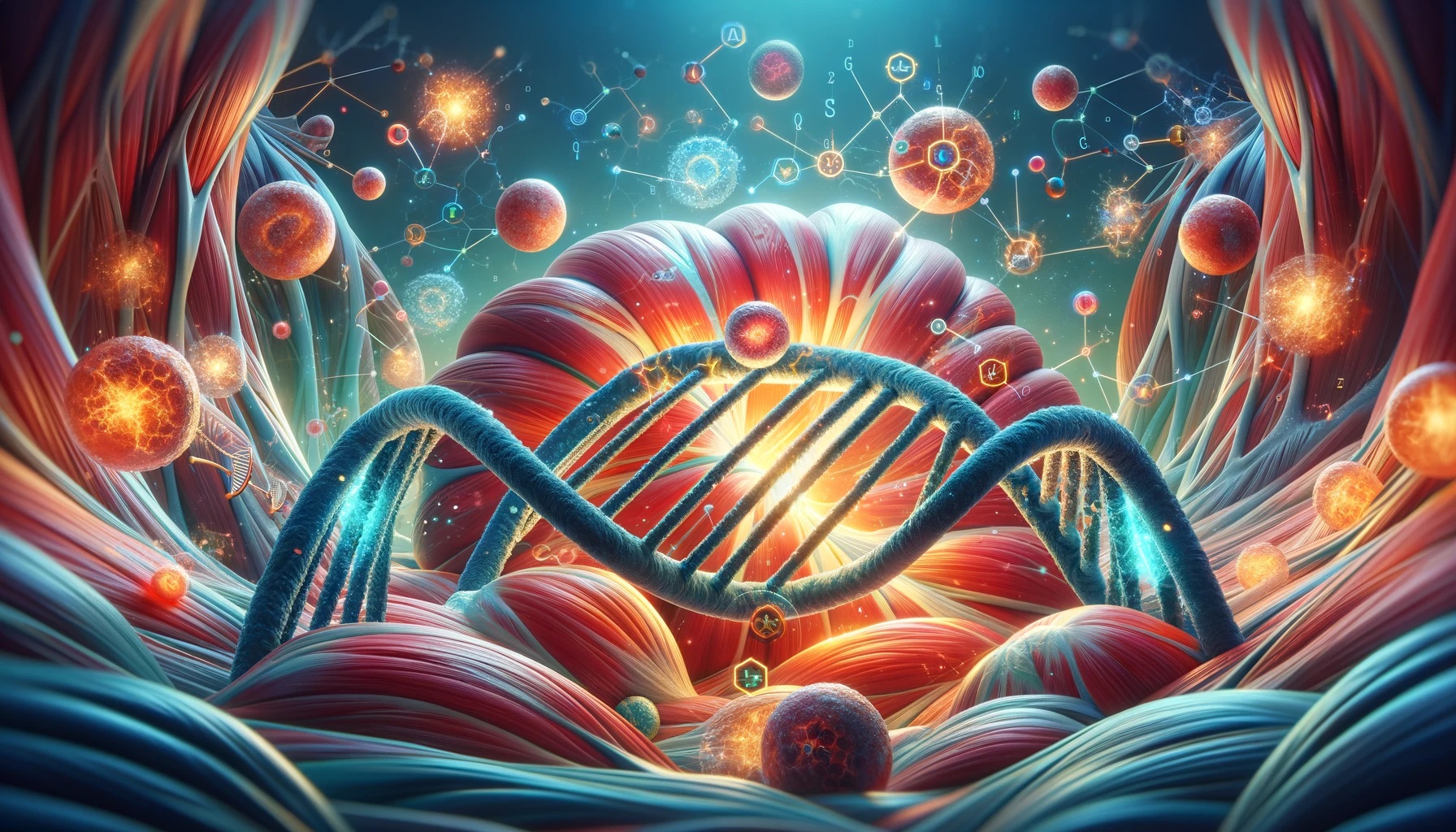· fitness · 16 min read
Unlocking Muscle Memory: A Key to Faster Strength Regain
Dive into the science of muscle memory and discover how it significantly affects muscle regrowth, strength training, and physical recovery.

In This Post
The Fact Why Should I Care How To Put In Action Start Tomorrow Guide How does it effect my ability to focus How does it impact my daily life How does it help me make friends How does it help me manage stress How does it effect my mood Summary: Remember Refresher Checklist The Full Research Article CitationsPrint Out The Tomorrow Checklist!
Sign up for our newsletter and receive a copy today, so that, you can start tomorrow! Or the next day, or the day after that. I forget everything and starting things is hard at least for me so these checklists are godsend.
Print Out The Remember Refresher Checklist!
Sign up for our newsletter and download your own copy of the Remember Refresher Checklist, so that, you can easily put it on your fridge and help you stay on target towards your WHY. Every little bit helps.
Introduction
Unraveling the Science Behind Muscle Memory
Muscle memory is often tossed around in fitness circles as a key factor in regaining strength and muscle size after a period of inactivity. But it’s much more than just a phrase tossed around in gyms; there’s real science behind it. Essentially, muscle memory involves both your brain and muscles to remember specific movements and strength levels, making it easier to regain them after a break.
This process is closely tied with neuromuscular adaptation, where repeated practice of physical movements leads to increased efficiency within the nervous system, resulting in improved strength and coordination over time. This fascinating process involves a combination of motor learning and adaptation of muscle fibers, contributing significantly to athletic performance enhancement and the ease of retraining muscles after a break from exercise.
The Significance of Myonuclei in Muscle Regrowth
The concept of myonuclei is critical when discussing muscle memory. During periods of muscle hypertrophy (when your muscles get bigger and stronger from, say, resistance exercise), your muscle fibers recruit new myonuclei from stem cells. These myonuclei act as control centers within the muscle cells, enabling the synthesis of new proteins, which in turn increases muscle size and strength.
What’s particularly compelling about myonuclei is their longevity. Even during periods of muscle atrophy (when muscles shrink due to disuse or underuse), these myonuclei remain in place. This biological artifact allows for quicker reactivation of muscle growth - hence, the “memory” part of muscle memory. This presence accelerates the process of regaining muscle size and strength once you resume training, making the role of myonuclei paramount in skeletal muscle regeneration and overall physical conditioning.
To understand the miracle of muscle memory fully, let’s delve deeper:
Myonuclei Retention: These cellular components remain within the muscle fibers even after periods of inactivity, ready to jump-start the process of protein synthesis in muscles necessary for growth.
Neuromuscular Efficiency: Practice not only improves muscular strength and size but also enhances the brain’s ability to perform movements more effectively and efficiently, contributing to neuromuscular adaptation.
Resistance Exercise as the Key: Engaging in strength training or resistance exercise is crucial in this whole process, as it directly affects muscle hypertrophy and the accumulation of myonuclei.
Checklist for understanding muscle memory and regrowth:
- Recognize the importance of myonuclei in muscle size and strength retention.
- Understand how neuromuscular efficiency is impacted by repeated movements and strength training.
- Acknowledge resistance exercise as the primary method of stimulating muscle growth and neuromuscular adaptation.
By grasping these foundational concepts, we’re better prepared to appreciate the intricate processes that allow our bodies to “remember” and rapidly regain lost strength, contributing to quicker recoveries and enhanced athletic performance.
Exploring Muscle Memory
Defining Muscle Memory: More Than Just Repetition
The term “muscle memory” might evoke images of an athlete or musician performing without much thought, their actions automatic and precise. However, in the world of fitness and strength training, muscle memory encompasses more than just the ability to replicate movements without conscious effort. It refers to the body’s capacity to regain strength and muscle size more rapidly after a period of inactivity or atrophy than it took to achieve that level of fitness in the first place. This phenomenon is not solely about the neuromuscular system and its adaptation to repetitive movements, but it also involves cellular and molecular changes within the muscles themselves. Key factors include:
- Myonuclei accumulation: Muscles contain cells called myonuclei that are essential for muscle growth. These cells remain even after muscle loss, making regrowth easier.
- Protein synthesis: The process by which cells build proteins. Muscle memory can enhance this process, leading to quicker muscle rebuilding.
- Neuromuscular adaptation: The nervous system’s ability to efficiently activate muscles becomes optimized through training, which can be “remembered” even after a break.
How Muscle Memory Benefits Athletes and Fitness Enthusiasts
For anyone who has ever taken a break from their fitness routine, be it due to injury, seasonal changes, or life’s usual disruptions, muscle memory is a silver lining. It grants a form of resilience and efficacy to training efforts that can greatly enhance motivation and outcomes. Here’s how:
- Rapid strength regain: Individuals can recover their lost strength and muscle mass at a notably faster rate than it took to gain them initially.
- Efficiency in retraining: After a hiatus, returning to a fitness routine is made less daunting, knowing that progress will come quicker than before.
- Adaptability: Muscle memory contributes to the body’s ability to adapt to different types of physical conditioning, from endurance to strength training, based on past experiences.
Checklist for Leveraging Muscle Memory:
- Consistent Training: Ensure regular engagement in strength training to build and maintain myonuclei in muscle cells.
- Balanced Nutrition: Support muscle repair and growth with a diet rich in proteins and essential nutrients.
- Adequate Rest: Allow muscles time to recover post-workout to maximize the benefits of muscle memory.
- Diverse Routines: Incorporate a variety of resistance exercises to stimulate muscle adaptation and memory in different muscle groups.
- Mind-Muscle Connection: Focus on the movement and muscles being worked on to enhance neuromuscular efficiency.
Muscle memory thus offers a beacon of hope for athletes and fitness enthusiasts alike, assuring that the path back to peak physical condition may be less arduous than the journey there. It underscores the body’s remarkable capacity for memory, not just within the confines of the brain, but across the muscular system, championing a more expedient return to form after periods of inactivity.
The Cellular Basis of Muscle Memory
Myonuclei: The Building Blocks of Muscle Memory
In the vast world of fitness and strength training, there lies a microscopic but mighty entity: myonuclei. These are the building blocks of muscle memory and play a pivotal role in muscle hypertrophy (growth) and regeneration. When you engage in resistance exercise or any form of strength training, you’re not just working your muscles; you’re also working on a cellular level, enhancing the number of myonuclei in your muscle fibers.
But what exactly are myonuclei? They are essentially the control centers within muscle cells that manage the synthesis of proteins essential for muscle repair and growth. Each myonucleus governs a specific domain within the muscle fiber, ensuring the efficient functioning and adaptation of the muscle in response to training.
Here’s why myonuclei are crucial for athletes and fitness enthusiasts:
- Muscle Hypertrophy: Myonuclei enable the growth of muscles by facilitating protein synthesis.
- Rapid Recuperation: More myonuclei mean faster recovery from muscle atrophy (loss) and injury, allowing quicker regain of strength and size.
- Long-term Strength Retention: Myonuclei remain in the muscle fibers even after periods of inactivity, enabling muscle memory and aiding in swift strength regain when training is resumed.
The journey to increasing myonuclei in your muscle cells is a testament to the marvels of human physiology and the incredible adaptability of our bodies to physical conditioning.
The Role of Resistance Training in Myonuclei Accumulation
If myonuclei are so beneficial, how do we increase their number in our muscle fibers? The answer lies in consistent and strategic resistance training. This form of exercise not only strengthens muscles but also contributes significantly to the accumulation of myonuclei, which is essential for long-term muscle adaptation and growth.
To effectively boost your myonuclei counts, include the following strategies in your workout routine:
- Gradual Overload: Increase the weight or resistance slowly over time to challenge your muscles continually.
- Variety of Exercises: Incorporate a mix of exercises to target different muscle groups and induce well-rounded muscle growth.
- Consistency: Maintain a regular training schedule to ensure continuous muscle stimulation and adaptation.
Here’s a simple checklist to follow for optimizing myonuclei accumulation through resistance training:
- Schedule training sessions at least 3-4 times a week.
- Include compound movements like squats, deadlifts, and bench presses to engage multiple muscle groups.
- Gradually increase the intensity of your workouts to challenge your muscles.
- Ensure a balanced diet to support muscle repair and growth.
- Allow adequate rest and recovery between sessions.
By following these guidelines and integrating resistance exercise into your fitness regimen, you make way for significant gains not only in muscle strength and size but also in neuromuscular efficiency and muscle memory. This optimizes your physical conditioning, enabling you to bounce back stronger from periods of inactivity or recover from injuries with greater ease.
Understanding the cellular basis of muscle memory through the lens of myonuclei and the impactful role of resistance training opens new vistas in achieving fitness goals. It underscores the importance of scientifically backed training methods in enhancing athletic performance and fostering a holistic approach towards physical wellbeing.
Practical Implications of Muscle Memory
Muscle memory is often thought of in terms of skill retention – like riding a bike or playing the piano after years without practice. However, its benefits extend far into the realms of physical conditioning and strength training, offering a unique advantage to athletes, fitness enthusiasts, and those recovering from injury. Let’s explore several key areas where muscle memory can be maximally leveraged to enhance performance, recovery, and overall physical health.
Strategies for Maximizing Muscle Memory Through Training
To take full advantage of muscle memory for athletic performance enhancement and faster strength regain, certain strategies can be adopted in your training regimen. Here they are laid out in a simple checklist:
- Regular Resistance Exercise: Encourage muscle hypertrophy and myonuclei accumulation by incorporating resistance training into your routine.
- Vary Your Workouts: Prevent neural adaptation and stimulate muscle growth through variability in your exercises.
- Focus on Form: Ensure proper technique to engage the correct muscles and enhance neuromuscular efficiency.
- Prioritize Rest: Allow adequate recovery periods to prevent muscle atrophy and promote protein synthesis in muscles.
- Stay Consistent: Regularity in training ensures that the neuromuscular system remains primed, facilitating retraining muscles when needed.
Myths and Misconceptions About Muscle Memory
Several myths surround muscle memory, often leading to misunderstandings about its role and benefits. One of the most common misconceptions is that muscle memory only applies to motor skills and not to muscle strength or recovery. However, as discussed, muscle memory is critical in skeletal muscle regeneration and hypertrophy, thanks to the role of myonuclei. Another myth is that once you stop exercising, muscle memory disappears. In reality, the physiological adaptations, such as the accumulation of myonuclei, can last for years, aiding in quicker retraining when physical activity is resumed.
Recovery and Retraining: Leveraging Muscle Memory after Injury
Muscle memory plays a pivotal role in recovery and retraining after an injury. The preservation of myonuclei even during periods of muscle atrophy means that once physical therapy or strength training is resumed, muscle regrowth is expedited. This principle is crucial for athletes returning to sport following an injury, as muscle memory can reduce the time it takes to regain pre-injury strength levels and neuromuscular efficiency. Effective recuperative strategies in sports should thus emphasize not just immediate injury management but also long-term training plans that harness muscle memory for faster rehabilitation.
Nutrition and Muscle Memory: Fueling for Faster Recuperation
Proper nutrition is foundational in supporting muscle memory and, subsequently, faster strength regain. A diet rich in protein is essential for facilitating protein synthesis in muscles, crucial for repair after exercise and injury. Additionally, adequate intake of vitamins and minerals supports the overall health of muscle tissue and promotes the anabolic state necessary for muscle growth. Here’s how you can align your nutrition with your training goals:
- Ensure adequate protein intake to support muscle repair and growth.
- Include a variety of fruits and vegetables to provide essential vitamins and minerals.
- Stay hydrated to facilitate optimal muscle function and recovery.
- Consider timing your nutrient intake to align with your training schedule for maximum benefits.
By integrating these practical strategies into your routine, you can leverage muscle memory for improved athletic performance, quicker strength regain after periods of inactivity, and more efficient recovery from injury. Understanding and applying the principles of muscle memory can transform how you approach your fitness goals, unlocking new levels of potential in your athletic endeavors.
FAQs on Muscle Memory: Addressing Common Queries
How Long Does it Take to Develop Muscle Memory?
One of the frequently asked questions is about the timeframe for developing muscle memory. The answer can vary depending on several factors such as the type of skill being learned, the frequency and intensity of training, and individual differences in physical conditioning and neuromuscular adaptation. However, certain patterns have emerged from research and practice:
- For simple physical tasks: It may take a few weeks of consistent practice for the muscle memory to begin forming.
- For complex skills: It might take several months to a year of regular, focused practice to deeply engrain these movements into muscle memory.
A crucial aspect to remember is that consistency is key. Regular practice signals the body to optimize neuromuscular efficiency, leading to more permanent adaptations.
Can Muscle Memory Help in Learning New Physical Skills?
Muscle memory doesn’t just play a role in regaining lost strength or skills; it’s also foundational in acquiring new physical skills. Here’s how:
- Reduces the cognitive load: As you become more proficient in a physical skill, your body learns to perform tasks without conscious thought, freeing up cognitive resources.
- Enhances neuromuscular coordination: Muscle memory helps in refining the coordination between muscles and nerves, improving overall skill execution.
- Improves physical adaptation: Regular practice promotes muscle hypertrophy and neuromuscular adaptation, making it easier to learn and perform new or related skills.
What Role Does Age Play in Muscle Memory and Retraining?
Age can influence the efficiency of muscle memory and the process of retraining muscles after a period of inactivity or muscle atrophy. Here are some points to consider:
- Younger individuals: Tend to have a quicker response to resistance exercise, with faster gains in muscle strength and hypertrophy. Their neuromuscular system adapts more readily to training stimuli, which can accelerate the development of muscle memory.
- Older adults: While sarcopenia (age-related muscle loss) and a slower physiological response to training can pose challenges, the basic principles of muscle memory apply. Older adults can still achieve significant improvements in strength and skill re-acquisition with consistent and appropriately designed training programs.
Checklist: Maximizing Muscle Memory Development
To harness the power of muscle memory effectively, here’s a simple checklist to follow:
- Consistent Practice: Engage in regular and focused training sessions.
- Progressive Overload: Gradually increase the intensity and complexity of your exercises.
- Variety in Training: Incorporate different exercises to promote overall neuromuscular adaptation and prevent plateauing.
- Adequate Nutrition: Fuel your body with the right nutrients to support muscle recovery and growth.
- Rest and Recovery: Ensure sufficient rest between training sessions to allow your muscles to repair and adapt.
- Mindful Movement: Pay attention to technique and body mechanics to deepen neuromuscular connections.
Muscle memory plays a crucial role not only in retraining and strength regain but also in learning new skills and adapting to various physical challenges. Age does impact the process, but with consistent practice, everyone can benefit from this remarkable aspect of human physiology.
Conclusion: Harnessing the Power of Muscle Memory for Future Training
Muscle memory is your body’s way of making strength regain and skill mastery more efficient. By understanding and leveraging the principles of muscle memory, athletes and fitness enthusiasts can accelerate their progress, recover from injuries more effectively, and achieve their training goals with greater ease.
Key Takeaways to Harness Muscle Memory:
Understand the Role of Myonuclei: Remember that the myonuclei accumulated during muscle hypertrophy remain in the muscle fibers even after periods of inactivity or muscle atrophy. This cellular foundation facilitates quicker muscle regrowth and strength regain when training resumes.
Incorporate Regular Strength Training: Consistent resistance exercise is crucial for accumulating myonuclei and enhancing muscle memory. It is the frequency and consistency of training that fundamentally shapes your neuromuscular efficiency and adaptation.
Focus on Recovery and Nutrition: To capitalize on muscle memory, prioritize recuperative strategies in sports and ensuring your diet supports muscle repair and growth. Proper nutrition fuels the protein synthesis in muscles necessary for hypertrophy and recovery.
Utilize Neuromuscular Adaptation: Understand that muscle memory extends beyond muscle size and strength. Neuromuscular adaptation improves your kinesthetic awareness and efficiency in performing physical activities, which is particularly beneficial for athletic performance enhancement.
Consider the Impact of Aging: Be aware that muscle memory and the capacity for muscle regrowth are influenced by age. However, regular physical conditioning can mitigate the effects of aging, such as sarcopenia, and promote skeletal muscle regeneration.
By embracing these principles and incorporating them into your training routine, you can effectively harness the power of muscle memory.
Checklist for Maximizing Muscle Memory in Your Training:
- Regularly engage in resistance exercise and strength training
- Focus on consistency to promote muscle hypertrophy and neuromuscular adaptation
- Follow a nutrition plan rich in proteins and nutrients essential for muscle repair
- Implement recovery strategies post-training to support muscle recuperation
- Adapt training routines as necessary to align with changes in physical conditioning and goals
Harnessing muscle memory isn’t just about building muscle or strength; it’s about optimizing the entire training process for superior results. Whether you’re an athlete aiming for performance enhancement or someone on a fitness journey, understanding and applying the concept of muscle memory can make all the difference in achieving your goals.
Relevant External Links
In the journey to unlocking the full potential of muscle memory for faster strength regain, continuous learning and staying updated with the latest research and insights are crucial. Here are three invaluable resources that can serve as beacons of knowledge in the vast sea of information about muscle memory, strength training, and the science of fitness.
National Strength and Conditioning Association (NSCA)
The National Strength and Conditioning Association stands at the forefront of strength training research and methodology. It offers a plethora of resources for fitness professionals, athletes, and enthusiasts keen on elevating their understanding and application of strength training principles.
Why this matters:
- Stay abreast of the latest research findings and methodologies in strength training.
- Understand the scientific underpinnings of physical conditioning and neuromuscular adaptation.
- Discover effective training programs backed by science to maximize muscle hypertrophy and strength regain.
American Physiological Society
Delve into the world of muscle memory mechanisms with the American Physiological Society. This platform provides deep insights into the physiological aspects of muscle development, adaptation, and recovery.
Benefits of this resource:
- Gain comprehensive knowledge about the cellular basis of muscle memory, including the role of myonuclei and satellite cells in muscle repair and regeneration.
- Explore studies on neuromuscular efficiency, the impact of resistance exercise, and the process of muscle atrophy and hypertrophy.
- Understand how factors like aging (sarcopenia) and physical conditioning influence muscle memory and retraining.
PubMed
For those who seek to dive deep into scientific studies and research papers, PubMed is a treasure trove. It houses an expansive library of research articles on myonuclei, muscle memory, protein synthesis in muscles, and much more.
What you’ll find here:
- Access to peer-reviewed studies on muscle fiber types, corticosteroid impact on muscles, and the anabolic state and muscle growth.
- Insights into the effectiveness of recuperative strategies in sports, endurance versus strength training, and the nuances of skeletal muscle regeneration.
- A broad spectrum of research regarding exercise physiology and neuromuscular adaptation.
Checklist for Maximizing Your Learning from These Resources:
- Regularly visit these websites to catch up on new research or publications.
- Apply the insights gained from these resources to your training or coaching methodologies.
- Share knowledge from these resources with peers or clients to promote a more informed fitness community.
- Consider incorporating findings from these studies into your recuperative or training strategies, especially after injuries.
- Stay curious and open to evolving your understanding of muscle memory and strength training based on emerging scientific evidence.
By leveraging the wealth of knowledge contained within these resources, you can further unlock the mysteries of muscle memory, enhance your strength training routines, and support others in their journey toward peak physical conditioning and recovery.





